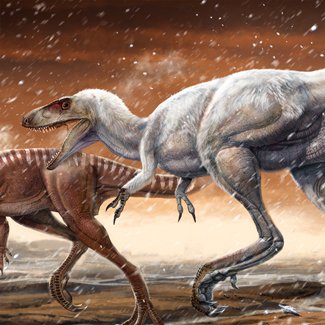Aussie T.rex claim disputed

THE AUSSIE T. REX RELATIVE described from a single bone by researchers earlier this year, and illustrated for the first time in Australian Geographic may not be a member of the tyrannosaur group after all.
Scientists from the University of Queensland argue that the bone belongs instead to a species from a completely different group.
In 2009, the pubic bone from a Museum Victoria collection was rediscovered after being hidden away in a drawer since 1989. Dr Tom Rich from the Museum Victoria took the bone to London where palaeontologists at the Natural History Museum decided it belonged to the first known Southern Hemisphere T. rex relative.
However, after studying the bone themselves, researchers Matt Herne and Dr Steve Salisbury from the University of Queensland dispute the original interpretation of some of the bone’s characteristics, as well as the idea that tyrannosaur-like species were ever present on the southern continent of Gondwana.
Bone of contention over Aussie T. rex
“We still don’t know a lot about the theropods [carnivorous dinosaurs], so to make a big call from just one bone challenges views of plate tectonics and asks bigger questions” says Matt. “If you make a big claim like this it is going to come under scrutiny.”
The dispute centres on the fragmented nature of the pubis bone, making its surface features difficult to interpret.
The Queensland researchers believe the bumpy surface of the bone was caused by crushing and erosion over time. Tom contends, however, that this surface represents part of a broken bone’s rippled internal structure. He thinks the rest of the bone – a small protruding nodule called a pubic tubercle, which would define the dinosaur as a T. rex – is missing, and presumed long gone.
The Queensland study, published last week in the journal Science, states the bone may belong to a group of dinosaurs already known from the Southern Hemisphere – possibly caracharodontosaurids, or maybe even a completely new group. The caracharodontosaurids were a group of giant carnivorous dinosaurs that roamed southern continents in the middle Cretaceous period, about 100 million years ago.
These massive predators were some of the largest ever to walk the Earth – some even bigger than the mighty T. rex. The caracharodontosaurid group also includes Australovenator (one specimen of which is known as Banjo), Australia’s most complete carnivorous dinosaur.
Dinosaur battleground set
In a response to the new claim, authors of the original research, including Tom, say they are adamant their tyrannosaur theory should stand. All theories like this “should be based on evidence, not expectation” they wrote in a second article in the same issue of Science. The fact that no evidence of tyrannosaurs has been found in Australia yet should not rule out the possibility that they were here, they argue.
Tom likens the identification process of dinosaurs to inferring the presence of an ancient building where only remnants of tiles, stumps and personal effects now lay. “In the same way, there is strong . . . evidence for the foundation of the pubic tubercle in the tyrannosauroid pubis from Dinosaur Cove,” he says.
The question of an Aussie ‘T. rex‘ will continue to be argued out in Australian palaeontology for some time, but there is one thing both Matt and Tom agree on: that is there is still huge scope for new discoveries in this currently dinosaur fossil-poor continent.
RELATED STORIES

